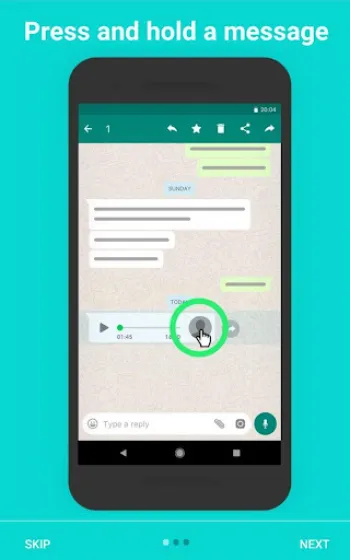Apps Home

The Evolution of Communication Efficiency in Messaging Apps
In the digital age, communication efficiency is paramount, and messaging apps like WhatsApp have become essential in daily life. These platforms evolved from simple text-based systems to feature-rich applications offering voice notes, enabling users to share emotions and context beyond what text alone can convey. However, as convenient as they are, long voice messages can be cumbersome to navigate, leading to the necessity for innovative solutions to streamline these interactions. The ability to speed up voice messages is a response to the fast-paced demands of modern communication. This function lets users manage their time more productively, ensuring they receive vital information without the temporal drag of extended listening sessions. Enhanced audio-playback functionality is crucial for professionals who rely on quick exchanges and need to absorb large amounts of information rapidly. Apps like “TalkFaster” offer features to accelerate voice recordings, consistent with the increasing trend towards productivity tools that integrate seamlessly into existing workflows. These functionalities aren’t just theoretically beneficial; they revolutionize user experiences by providing technological means to skip unnecessary silences and compress communication without losing essence. Asynchronous communication can now have the immediacy of live discussions, too. The transition from text to voice in messaging was a natural evolution, addressing the limitations of typing and reading time constraints. Speeding up voice messages adds another layer of efficiency, allowing users to customize their consumption of information, adapting to different contexts and needs. Such advancements exemplify how technology continually transforms user interactions, streamlining tasks, and shaping new norms in digital communication. The rise of customizable speed settings, silent listening that doesn't alert the sender, and cross-platform compatibility underscores how these developments are rooted in real-world user requirements. These innovations not only enhance individual productivity but also redefine how efficiently communities can operate in unison within digital ecosystems. The evolving landscape of messaging apps is a testament to the unyielding human drive for more effective communication mechanisms.
Technical Aspects of Voice Message Acceleration
The technical underpinnings of voice message acceleration in apps like TalkFaster are rooted in complex algorithms that process audio data while preserving the integrity of the sound. Implementing multiple playback speeds requires sophisticated audio processing techniques that alter the playback rate without affecting the pitch, which can result in unnatural or unintelligible distortions. This involves manipulating the audio waveform using what's commonly known as time-stretching and pitch-shifting algorithms. Time-stretching allows the speed of the playback to change independently of pitch. In voice processing, particular attention is given to speech intelligibility, which is critical when listening to accelerated speech. The technology leverages fast Fourier transforms (FTFs) to break down signals into their component frequencies, enabling selective enhancements or suppressions that maintain clarity and intelligibility at higher speeds. Additionally, the feature to skip silences uses voice activity detection, a process that identifies non-speech segments and omits them during playback. This functionality requires an accurate analysis of audio patterns to distinguish between silence, noise, and speech reliably. Furthermore, maintaining cross-platform compatibility—so users can enjoy features consistently on any device—demands a streamlined, flexible audio processing framework adaptable across different operating systems. Each system necessitates unique optimizations given its native APIs, processing capabilities, and software environments. The app’s ability to function without marking messages as “read” showcases another technical feat: it interacts indirectly with messaging app APIs, allowing file sharing without triggering read receipts. This involves app-to-app communication via shared storage permissions, a delicate task that balances functionality with privacy and security concerns users increasingly demand. As these technologies develop, the cornerstone of future enhancements will likely involve AI-driven improvements, optimizing audio processing further, and offering even more sophisticated user controls. Real-time processing advancements will push the development boundaries, leading to faster, more accurate handling of various audio inputs, ensuring quality remains high even under extreme user-specified settings. The field continuously innovates, reflecting a broader trend in software development toward more personalized, control-rich user experiences.
Practical Applications of Accelerated Audio Features
The practical applications of accelerated audio playback extend beyond mere convenience, significantly impacting productivity and time management in personal and professional domains. For instance, in a business context, streamlined communication is crucial, and speeding up voice messages can greatly aid in managing large volumes of communication without sacrificing content comprehension. Meetings often generate extensive audio, and the ability to listen to these recordings faster enables professionals to capture key points swiftly and efficiently. This is particularly beneficial in multinational companies with remote teams spread across different time zones, where asynchronous communication methods like voice messages are frequently used. Academically, students and educators can benefit by reviewing lectures and recorded discussions at accelerated speeds, doubling efficiency and allowing more time for critical thinking and analysis. Effective use of such technology can lead to better learning outcomes and greater flexibility in how educational content is consumed. In everyday life, individuals juggling various personal commitments appreciate the ability to compress information intake; listening to lengthy messages from family and friends in a reduced time frame frees up valuable time for other activities. This concept of time optimization also plays into the wider social dynamic, enhancing personal interactions by enabling users to remain connected without becoming overwhelmed by the volume of digital communication. The silent listening capability addresses privacy concerns, important in scenarios where discretion is required, allowing secretaries to screen messages or journalists to gather information without alerting sources prematurely. Beyond immediate personal benefits, such functionalities represent a move towards smarter, technology-driven lifestyles where information accessibility and time-saving techniques converge. In sum, the practical deployment of speed controls in audio apps extends across all facets of modern life, serving diverse needs and ensuring technology aligns more closely with the expectations of an efficiency-conscious society.
Challenges and Solutions in Deploying Speed-Up Features
Implementing speed-up features in applications like TalkFaster involves overcoming significant challenges, chief among them being maintaining audio quality and comprehensibility at accelerated rates. As audio is sped up, there is an inherent risk of distorting speech to the point where it becomes indiscernible, a challenge tackled by exploring advanced audio processing technologies such as phase vocoders and time-domain algorithms. Delivering seamless integration across various platforms also poses a challenge, as each operating system—Android, iOS, and others—presents a unique set of capabilities and limitations concerning audio playback and processing. Crafting a uniform experience that feels native on each device while maintaining performance and feature parity requires a robust understanding of each platform’s audio APIs and system frameworks. Another challenge is ensuring that speed-up features work globally with voice messages that may contain numerous languages and dialects, which introduces complexities in designing algorithms that handle diverse phonetic structures effectively. Privacy issues also arise when dealing with audio files, as processing these files involves temporary storage or transmission, necessitating secure protocols to protect user data. The solution involves leveraging secure storage options and robust encryption standards to ensure messages are processed without compromising user privacy. The effort to remain user-friendly is another hurdle, entailing careful design of user interfaces that simplify feature access while providing comprehensive controls for custom speed settings. User feedback loops are essential, allowing developers to fine-tune applications to better meet user expectations and adhere to evolving privacy laws. Incorporating machine learning could also streamline the experience by personalizing audio processing based on individual preferences and habits, potentially automating and optimizing playback speeds based on content analysis. Meeting these challenges head-on ensures that speed-up features do not degrade the user experience but rather enhance and expand the ways individuals and organizations interact with voice messages in their digital communications.
The Future of Voice Message Optimization Technologies
Looking ahead, the evolution of voice message optimization technologies promises even more groundbreaking advancements in how we communicate. Emerging trends suggest that integration with advanced artificial intelligence will take center stage, providing smart suggestions and automating routine tasks to provide users with a more intuitive interaction model. As AI becomes more sophisticated, audio processing will likely benefit from real-time enhancements that adjust playback dynamically to suit content context and user preferences. This adaptability could foreseeably extend beyond simple speed adjustments, incorporating ambient sound balancing, speech enhancement, and customized sound profiles that users can tailor based on their current environment, such as commuting, quiet spaces, or noisy public areas. As these technologies advance, they will likely become less about simply accelerating playback and more about transforming raw audio data into a richer, more immersible communication channel that offers features such as voice-to-text with learned speaker nuances and sentiment analysis that helps convey the message’s tone. These technologies could be combined with other innovations, such as augmented reality interfaces that project information in more accessible formats, transforming ambient processing of audio data. Legal and ethical considerations will continue to guide the evolution of these tools, especially concerning privacy and the secure handling of personal data. Small innovations in this domain have already started manifesting in personalized assistants and automation scripts for managing communication tasks, hinting at a future where users spend significantly less time on information retrieval and more on meaningful engagement and productivity. The ongoing convergence of these technologies not only has the potential to redefine how people use digital communication tools but will ultimately transform the broader landscape of digital interaction, encouraging a more interconnected and efficiently managed online environment. As users grow accustomed to the increased functionality and understanding offered by these advancements, it's clear that the future of voice message technology will continue to shift towards a system that values and protects user time as never before, aligning neatly with the demands of an increasingly dynamic global digital community.
Share Your Opinion
Your Email Will Not Be Published.
All Rights Reserved © Apps Home 2025



























Seb P.
Amazing. I send so many vocals since I am lazy to Always write...so do my friends. And this extension saves me lots of time. You can speed up vocal...
Sugen Kumar PS4 (Sugendran)
Thank you very much Will consider giving some donation in near future. Very good app. Most of my groups are voice message group. This app saves lot...
A Google user
I think I love this app. I have a friend that leaves very long voice notes and my phone acts up the whole time, but this app is such a time and san...
Basith Bazi
Very nice and simple idea 👌👌. It's very good especially for college students who are attending online classes in WhatsApp 😇. Saves much time fro...
aziz
I really really happy to know this app. I have been looking for update on the WhatsApp that support apply this action for a long time. I have small...